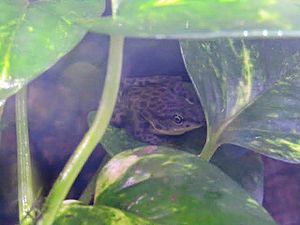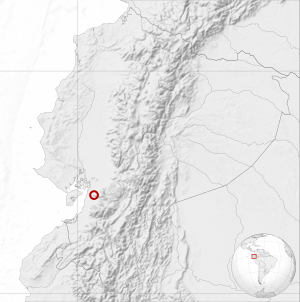Rio Pescado stubfoot toad facts for kids
Quick facts for kids Rio Pescado stubfoot toad |
|
|---|---|
 |
|
| Atelopus balios in Awashima marine park | |
| Conservation status | |
| Scientific classification | |
| Genus: |
Atelopus
|
| Species: |
balios
|
 |
|
The Atelopus balios, also known as the Rio Pescado stubfoot toad, is a special type of toad that belongs to the Bufonidae family. This small toad lives only in southwestern Ecuador, a country in South America. It has been found in the lowlands of Azuay, Cañar, and Guayas Provinces.
For a long time, people thought this toad might be extinct, meaning it had completely disappeared from Earth. But in 2011, a team from Conservation International found one single Atelopus balios! This was exciting news, as many types of amphibians (like frogs and toads) are disappearing around the world. The Rio Pescado stubfoot toad is now listed as Critically Endangered. This means it is at a very high risk of becoming extinct in the wild. A big reason for this danger is a serious fungus called Chytridiomycosis, which has harmed many amphibian populations. Scientists have only found ten tadpoles of this toad so far.
What Does It Look Like?
Adult male Rio Pescado stubfoot toads are about 2.7 to 2.9 centimeters (about 1 inch) long from their snout to their rear end. Females are a bit bigger, measuring about 3.5 to 3.7 centimeters (about 1.4 inches).
This toad has a pointy snout and long, thin legs. Its fingers and toes are partly webbed, like a duck's foot, which helps it swim. Its back is olive green and covered with round black spots. These spots also go down onto its legs. The palms of its hands, the soles of its feet, the webbing between its toes, and the area around its rear are all bright orange. Its belly is mostly creamy yellow, with some black spots along the edges. The toad's tail is quite long, making up about half of its total body length.
Where Does It Live and Why Is It in Danger?
The Atelopus balios lives in tropical lowland rainforests. These forests are found at elevations between 200 and 460 meters (about 650 to 1,500 feet) above sea level. Some reports even say they can be found up to 900 meters (about 3,000 feet) high.
This toad is a night animal, meaning it is most active after the sun goes down. It likes to live near streams. The biggest threats to the Rio Pescado stubfoot toad are the chytridiomycosis fungus and the loss of its home. Its habitat is being destroyed by farming, cutting down trees (logging), and pollution. Sadly, the areas where this toad lives are not currently protected by any national parks or reserves.
See also
 In Spanish: Jambato del río Pescado para niños
In Spanish: Jambato del río Pescado para niños


